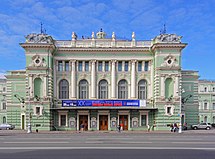 |
| Krasnoyarsk State Opera House
Author MaxBioHazard
Licence Creative Commons Attribution-Share Alike 4.0 International Source Wikipedia Krasnojarsk |
The Russian State Ballet of Siberia La Fille mal gardée 15 Feb 2019 Liverpool Empire
Krasnoyarsk is a city in Siberia with a population of just over a million on approximately the same latitude as Dundee. According to Google Maps, it is 4,559 miles away and takes over 14½ hours to reach by air or 5 days by surface transportation.
An opera house with a resident ballet company opened in that city in 1978. The company's founder members included graduates of the Vaganova Ballet Academy and the Moscow State Academy of Choreography. Krasnoyarsk has produced some fine dancers over the years despite its remoteness and modest population. They include Anna Ol of the Dutch National Ballet and Viktoria Tereshkina of the Mariinsky. Many of those dancers trained or began their training in the city and some such as Ol danced with the Krasnoyarsk opera house company.
Every year artists from the Krasnoyarsk opera house ballet tour the United Kingdom as The Russian State Ballet of Siberia (see Anna Lidster Promoting Krasnoyarsk: How the Russian State Ballet of Siberia has won British hearts 3 March 2013 The Siberian Times). I am not sure why they chose that name. It may be that they think that the name of their city might be a bit of a mouthful for British tongues or it may be because they recruit a few extra dancers for the tour such as Francesco Bruni and Francisco Gimenez. However, it is clear from comparing the Russian State Ballet of Siberia's programme with the Krasnoyarsk opera house's website that the two companies are substantially the same.
The tourists have a punishing schedule. They opened at St David's Hall in Cardiff with The Snow Maiden on 19 Dec 2018 and they will finish in Oxford on 16 March 2019 with Swan Lake. By the end of their tour, they will have performed 6 full-length ballets in 24 venues in every one of our constituent nations except Northern Ireland. On Friday they reached Liverpool which is where I saw them for the first time.
I was attracted to Liverpool by the show rather than by the company. They were to dance La Fille mal gardée with music by Hertel rather than Lanchbery and choreography by Gorsky rather than Ashton. La Fille mal gardée is in one sense the oldest ballet in the modern repertoire having first been performed at the Grand Théâtre de Bordeaux less than a fortnight before the storming of the Bastille but the version that we know was premiered in 1960.
To my great surprise and joy, Friday's performance was not at all inferior to the Ashton-Lanchbery-Lancaster version. I would go so far as to say that I left the Empire somewhat more elated than when I left the Lowry in October after seeing BRB's latest production which had somehow expanded into three acts. The story was very much the same. The only significant difference is that Colas gets into Simone's house disguised as a notaire rather than hidden under a bundle of wheat sheaves.
There were a few other differences. Instead of churning butter half-heartedly, a distracted Lise collected a couple of eggs from the henhouse while her mother gathered a basketful. Nobody dressed as poultry though there were computer generated animations of pigs and other animals crossing the backcloth which earned a few laughs from the audience. There was a sort of ribbon dance but it did not end up as a love knot and Simone performed a clog dance though not the one we know. Alain was not swept into the sky by the storm clutching his umbrella. Nor was he made to resemble a carthorse.
But there were elements that do not occur in the Ashton version such as a full-blown classical pas de deux complete with entrée, male and female solos and coda. Lise dons a classical tutu which could not possibly have been in the Dauberval version. In the Russian version, Lise dances at least as many fouettés as Odile in Swan Lake or Kitri in Don Quixote.
As in Ashton's version, Simone was danced by a man. In this case Pavel Kirchev, a Bulgarian guest artist who dances with the Varna ballet. He reminded me quite a lot of Stanley Holden. Elena Svinko was a delightful Lise, coquettish and feisty. She had teeth and she used them on poor Alain (Ilia Kaprov) biting his fingers and ear and stamping on his foot as he tried to express affection. Marcello Pelizzoni, who trained in Moscow and dances with the Krasnoyarsk ballet, was Colas. He has impressive elevation, power and grace and I delighted in his virtuosity.
Considering the time they must have spent on the road and the need to pack and repack almost every day I was pleasantly surprised that the sets and costumes seemed so fresh and that the cast had so much energy. I shall try to catch their Swan Lake when they come to Halifax or Sheffield.

